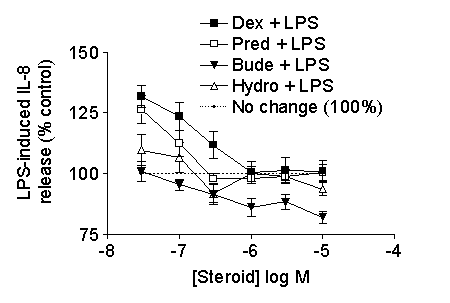| pA2 online © Copyright 2004 The British Pharmacological Society |
129P
University of Bath Summer Meeting July 2004 |
|
Differential effects of steroids on IL-8 release by THP-1 monocytes stimulated with TLR2 or TLR4 ligands Toby Lo, Mark Paul-Clarke, Matthew Walters & Jane A. Mitchell. Cardiothoracic Pharmacology, UCCM, Royal Brompton Hospital, NHLI, Imperial College London. SW3 6LY |
|
Corticosteroids are potent anti-inflammatory therapies used in a number of chronic conditions including asthma and arthritis. However, steroids are not useful therapies in the treatment of systemic inflammation associated with pathogen insult, and in some cases, steroid treatment can exacerbate such conditions ( Cronin et al., 1995).Here we havecompared the ability of a range of clinically relevant steroids to inhibit IL-8 release by human THP-1 monocytes stimulated with LPS, which is a Toll like receptor (TLR)4 ligand that mimics the effects of Gram negative bacteria and PAM3CSK4 which is a TLR2 ligand that mimics some of the effects of Gram positive bacteria ( Takeuchi et al., 1999).
THP-1 monocytes were plated in 96-well plates and incubated in RPMI1640 containing FCS (2%). Cells were treated with the following steroids for 2 hours: budesonide, prednisolone, dexamethasone or hydrocortisone. Cells were then stimulated by the addition of LPS (10 µg/ml) or PAM3CSK4 (300ng/ml) for 24 hours. IL-8 was then measured using ELISA. THP-1 cells released low basal levels of IL-8 (22 ± 2pg/ml) which was increased by either LPS (497 ± 38pg/ml) or PAM3CSK4 (437 ± 36pg/ml).

Effect of dexamethasone (Dex, black square), prednisolone (Pred, white square), budesonide (Bude, black triangle) or hydrocortisone (Hydro, white triangle) on LPS-induced release of IL-8 by THP-1 monocytes. Results are the mean ± S.E.M. for n=8-16 wells from 4-8 experimental days.
Neither dexamethasone, prednisolone nor hydrocortisone inhibited LPS induced IL-8 release. By contrast, budesonide induced concentration dependent inhibitions of LPS-induced IL-8 release. Similarly in cells stimulated with PAM3CSK4, budesonide inhibited IL-8 release to 57 ± 4% of control at 10-5M, whilst prednisolone (10-5M) had no inhibitory effect (93% of control) on PAM3CSK4 induced IL-8 release (n=9).
Here we show that when monocytes are stimulated with bacterial mimetics, some steroids increase IL-8 release. IL-8 is an important chemoattractant cytokine for neutrophils. We therefore suggest that steroid-induced IL-8 release may contribute to the lack of effectiveness of steroids in the treatment of some conditions where neutrophils predominate (e.g. sepsis, COPD and ARDS). The finding that budesonide was the only steroid to effectively inhibit IL-8 release by TLR2 or TLR4 ligands may suggest a usefulness of this drug in the treatment of Gram negative or Gram positive sepsis.
Cronin, L et al., (1995), Crit Care Med 23: 1430-9
Takeuchi, O et al., (1999), Immunity. 11: 443-51